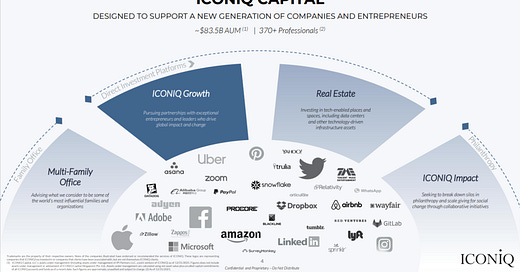Inside ICONIQ Capital: How the Rich Got Richer
Secret documents reveal how ICONIQ Capital accumulated $83.5 billion in the bull run and raised $6 billion as the world came undone.
If there’s any investment firm that’s truly a backroom cabal of rich and powerful tech elites, it’s Divesh Makan’s ICONIQ Capital. The firm counts some of the wealthiest and most connected billionaires in the world as clients and consiglieres.
ICONIQ has been in the process of raising its seventh growth fund. I can report that the fund — ICONIQ Strategic Partners VII— has been raised and totals $6 billion, according to a source. That gives the firm a deep reserve of dry powder as tech stocks — including ICONIQ portfolio companies like Snowflake and Datadog — crater. A spokesperson for ICONIQ declined to comment.
If you know anything about ICONIQ, it’s probably that the firm built its reputation on the back of managing some of Mark Zuckerberg’s enormous fortune.
A private fundraising presentation that I’ve obtained makes clear that Zuckerberg, who remains an advisor to the firm, is far from the only headline name with deep connections to ICONIQ.
The firm’s advisory board comprises some of the most powerful investors and tech business leaders in the world: LinkedIn co-founder Reid Hoffman, Asana CEO Dustin Moskovitz, Yahoo! co-founder Jerry Yang, General Motors CEO Mary Barra, Johnson & Johnson executive chairman Alex Gorsky, Tiger Global founder Chase Coleman, founding TPG partner David Bonderman, co-CEO of KKR Henry Kravis, Indian steel magnate Aditya Mittal, and Zuckerberg.
Since ICONIQ was founded in 2011, Makan has exploded the firm’s reach. ICONIQ is at once a family office for the ultra wealthy, a growth fund that competes with the likes of Tiger Global, a major real estate investor, and an impact investor. ICONIQ has invested in more than 120 companies, deploying $12.9 billion in capital.1
Just as this epic bull run looked to be coming to a close — at the end of last year — ICONIQ’s assets under management totaled $83.5 billion, according to the private investor presentation.2
What becomes of that massive wealth horde is an open question. Careers and fortunes are made at the tail end of a bull cycle. ICONIQ returned billions to its investors last year. But the firm deployed just as many billions. Will ICONIQs financial backers remember the money it returned or the expensive investments that it made in 2021?
Clearly, there are still plenty of believers given investors ponied up $6 billion for ICONIQ’s seventh fund as the stock market comes undone.
With the benefit of hindsight, it’s fair to say ICONIQ was almost certainly overexuberant last year. ICONIQ paid difficult-to-justify-in-retrospect prices for much of the $5.2 billion it invested last year. High entry prices will make it hard for the firm’s sixth fund to match the stellar returns of its early funds.
But that will be true for many, if not all, of the firm’s rivals too. (Collective delusions are a powerful force — and there are plenty of incentives to run off the cliff together.)
There’s little question that 2021 was an epic year for ICONIQ that helped shape the future of the technology industry.
Last year, ICONIQ’s headcount grew by 22%. It saw 16 liquidity events, including 11 portfolio company public listings.
The firm invested— just last year — $5.2 billion. The firm bought shares in 37 new companies and made 60 follow-on investments.
Again, just last year, the firm says it returned $5.5 billion to its backers, at a realized gross multiple on invested capital of 8.3x.
Much of this story is based on the fundraising materials for that seventh fund. The slides (many of which are included below for Newcomer subscribers) contain ICONIQ’s performance through Dec. 31, 2021.
If you want to know how the rich got richer before the world started to unravel, this is the story that explains how.





